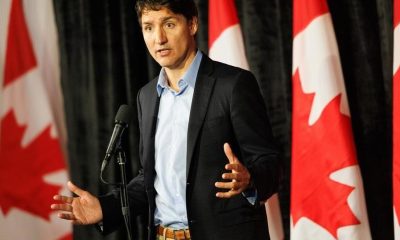Media
The Taliban embrace social media: 'We too want to change perceptions' – BBC News

In early May, as US and Nato forces began their final withdrawal from Afghanistan, the Taliban stepped up their military offensive against Afghan national security forces.
But they also did something less common in the group’s history of conflict in the country – they launched a comprehensive social media campaign to go with it.
A network of social media accounts highlighted the alleged failures of the Kabul government while lauding the Taliban’s achievements.
Tweets boasted about the group’s recent victories – sometimes prematurely – and pushed several hashtags, including #kabulregimecrimes (attached to tweets accusing the Afghan government of war crimes); #westandwithTaliban (an attempt to drive grassroots support) and #ﻧَﺼْﺮٌ_ﻣٌِﻦَ_اللهِ_ﻭَﻓَﺘْﺢٌ_ﻗَﺮِﻳﺐٌ (help from God and victory is near). The first of the hashtags at least trended in Afghanistan.
In response, Afghanistan’s then-Vice President Amrullah Saleh warned his forces and the public not to fall for false claims of Taliban victories on social media, and called on people to avoid sharing details of military operations that could compromise security.
The coordination suggested the Taliban had moved on from the staunch opposition to modern information technology and media once associated with them, and built a social media apparatus to amplify their message.
When the Taliban first came to power in Afghanistan in 1996, they banned the internet and confiscated or destroyed television sets, cameras, and video tapes. In 2005, the official website of Islamic Emirates of Taliban, ‘Al-Emarah’, was launched and now publishes content in five languages – English, Arabic, Pashto, Dari, and Urdu. The audio, video, and written content is overseen by the cultural commission of Islamic Emirates of Afghanistan (IEA), headed by their spokesperson Zabihullah Mujahid.
Zabihullah Mujahid’s first Twitter account was suspended by the company, but his new account – active since 2017 – has more than 371,000 followers. Underneath him is a dedicated team of volunteers promoting the Taliban’s ideology online.
The reported head of that group – effectively the social media director of the IEA – is Qari Saeed Khosty.
Mr Khosty told the BBC the team had separate groups focused on Twitter – attempting to get Taliban hashtags trending – as well as disseminating messages on WhatsApp and Facebook.
“Our enemies have television, radio, verified accounts on social media and we have none, yet we fought with them on Twitter and Facebook and defeated them,” Mr Khosty said.
His job, he said, was to take people who had joined the Taliban because of its ideology and “bring them to social media platforms so they amplify our message”.
There are just 8.6 million internet users in Afghanistan, and absence of network coverage and affordable data remains a key challenge. The IEA social media team team pays 1,000 Afghanis (£8.33; $11.51) per month for data packages for team members “fighting their war online”, Mr Khosty said.
He boasted that the IEA had “four fully equipped multimedia studios that are used for generating audio, video content and digital branding”.
The result is high-quality propaganda videos glorifying Taliban fighters and their battles against foreign and national forces, widely available on their YouTube and Al-Emarah websites.
The group publishes freely on Twitter and YouTube, but Facebook has designated the Taliban a “dangerous organisation” and frequently removes accounts and pages associated with them. Facebook has said it will continue to ban Taliban content from its platforms.
Mr Khosty told the BBC the Taliban was finding it hard to sustain their presence on Facebook, and was focusing instead on Twitter.
Although the US State Department has designated the Haqqani Network as an international terrorist group, their leader Anas Haqqani and many members of the group have Twitter accounts with thousands of followers.
Speaking on condition of anonymity, one member of the Taliban’s social media team told the BBC that the team decided to use Twitter in earnest to promote a New York Times opinion article written by Sirajuddin Haqqani, the deputy leader of the Taliban, in February 2020. Most of the active Taliban accounts on Twitter were created after that.
“Most Afghans don’t understand English, but the leaders of the Kabul regime actively communicated in English on Twitter – because their audience is not Afghans but the international community,” he said.
“The Taliban wanted to counter their propaganda and that’s why we too focused ourselves on Twitter.”

- ANALYSIS: What rise of Taliban means for Pakistan
- BACKGROUND: The story of Afghanistan’s ‘undefeated’ valley
- ON THE GROUND: In Kabul, Afghans adjust to a new, uncertain fate
- VOICES: Kabul make-up artist: ‘Women like me are targets’

He said the team members, some of whom have tens of thousands of followers, were issued specific guidelines “not to comment on the foreign policy issues of neighbouring countries that would constrain our relations with them”.
In the past, the Taliban were known for being highly secretive about the identity of their leaders and fighters. So much so that there are barely any clear pictures of group’s founder, Mullah Omer.
Today, in an effort to gain international legitimacy, their leadership is not only making media appearances but promoting them heavily on social media. When the group’s previously secretive spokesman, Zabihullah Mujahid, made a press conference appearance shortly after the fall of Kabul, the profile pictures of many Taliban Twitter accounts were changed to his image.
By contrast, many Afghan citizens who worked for international forces, organisations, media and others who were critical of the Taliban on social media are now deactivating their accounts, fearing that the information could be used to target them.
Human rights organisations Amnesty International and Human Rights Watch say they have already received reports of Taliban fighters searching for, and allegedly killing, people in reprisal attacks.
Facebook has launched a one-click tool for people in Afghanistan to quickly lock down their account, preventing anyone not already listed as a friend from seeing their details. The site also announced it had temporarily removed the ability to view and search the “Friends” list for accounts in Afghanistan.
The question is whether the Taliban have changed and abandoned the brutality associated with the group. Many in Afghanistan and around the world do not believe their promises of change.
But they appear to have grasped that some of the technology they once shunned can help them in their quest to shape opinion on a global stage.
“Social media is powerful tool to change public perception,” said the social media team member. “We want to change the perception of the Taliban.”
Media
Trump could cash out his DJT stock within weeks. Here’s what happens if he sells
Former President Donald Trump is on the brink of a significant financial decision that could have far-reaching implications for both his personal wealth and the future of his fledgling social media company, Trump Media & Technology Group (TMTG). As the lockup period on his shares in TMTG, which owns Truth Social, nears its end, Trump could soon be free to sell his substantial stake in the company. However, the potential payday, which makes up a large portion of his net worth, comes with considerable risks for Trump and his supporters.
Trump’s stake in TMTG comprises nearly 59% of the company, amounting to 114,750,000 shares. As of now, this holding is valued at approximately $2.6 billion. These shares are currently under a lockup agreement, a common feature of initial public offerings (IPOs), designed to prevent company insiders from immediately selling their shares and potentially destabilizing the stock. The lockup, which began after TMTG’s merger with a special purpose acquisition company (SPAC), is set to expire on September 25, though it could end earlier if certain conditions are met.
Should Trump decide to sell his shares after the lockup expires, the market could respond in unpredictable ways. The sale of a substantial number of shares by a major stakeholder like Trump could flood the market, potentially driving down the stock price. Daniel Bradley, a finance professor at the University of South Florida, suggests that the market might react negatively to such a large sale, particularly if there aren’t enough buyers to absorb the supply. This could lead to a sharp decline in the stock’s value, impacting both Trump’s personal wealth and the company’s market standing.
Moreover, Trump’s involvement in Truth Social has been a key driver of investor interest. The platform, marketed as a free speech alternative to mainstream social media, has attracted a loyal user base largely due to Trump’s presence. If Trump were to sell his stake, it might signal a lack of confidence in the company, potentially shaking investor confidence and further depressing the stock price.
Trump’s decision is also influenced by his ongoing legal battles, which have already cost him over $100 million in legal fees. Selling his shares could provide a significant financial boost, helping him cover these mounting expenses. However, this move could also have political ramifications, especially as he continues his bid for the Republican nomination in the 2024 presidential race.
Trump Media’s success is closely tied to Trump’s political fortunes. The company’s stock has shown volatility in response to developments in the presidential race, with Trump’s chances of winning having a direct impact on the stock’s value. If Trump sells his stake, it could be interpreted as a lack of confidence in his own political future, potentially undermining both his campaign and the company’s prospects.
Truth Social, the flagship product of TMTG, has faced challenges in generating traffic and advertising revenue, especially compared to established social media giants like X (formerly Twitter) and Facebook. Despite this, the company’s valuation has remained high, fueled by investor speculation on Trump’s political future. If Trump remains in the race and manages to secure the presidency, the value of his shares could increase. Conversely, any missteps on the campaign trail could have the opposite effect, further destabilizing the stock.
As the lockup period comes to an end, Trump faces a critical decision that could shape the future of both his personal finances and Truth Social. Whether he chooses to hold onto his shares or cash out, the outcome will likely have significant consequences for the company, its investors, and Trump’s political aspirations.

Media
Arizona man accused of social media threats to Trump is arrested

Cochise County, AZ — Law enforcement officials in Arizona have apprehended Ronald Lee Syvrud, a 66-year-old resident of Cochise County, after a manhunt was launched following alleged death threats he made against former President Donald Trump. The threats reportedly surfaced in social media posts over the past two weeks, as Trump visited the US-Mexico border in Cochise County on Thursday.
Syvrud, who hails from Benson, Arizona, located about 50 miles southeast of Tucson, was captured by the Cochise County Sheriff’s Office on Thursday afternoon. The Sheriff’s Office confirmed his arrest, stating, “This subject has been taken into custody without incident.”
In addition to the alleged threats against Trump, Syvrud is wanted for multiple offences, including failure to register as a sex offender. He also faces several warrants in both Wisconsin and Arizona, including charges for driving under the influence and a felony hit-and-run.
The timing of the arrest coincided with Trump’s visit to Cochise County, where he toured the US-Mexico border. During his visit, Trump addressed the ongoing border issues and criticized his political rival, Democratic presidential nominee Kamala Harris, for what he described as lax immigration policies. When asked by reporters about the ongoing manhunt for Syvrud, Trump responded, “No, I have not heard that, but I am not that surprised and the reason is because I want to do things that are very bad for the bad guys.”
This incident marks the latest in a series of threats against political figures during the current election cycle. Just earlier this month, a 66-year-old Virginia man was arrested on suspicion of making death threats against Vice President Kamala Harris and other public officials.
Media
Trump Media & Technology Group Faces Declining Stock Amid Financial Struggles and Increased Competition

Trump Media & Technology Group’s stock has taken a significant hit, dropping more than 11% this week following a disappointing earnings report and the return of former U.S. President Donald Trump to the rival social media platform X, formerly known as Twitter. This decline is part of a broader downward trend for the parent company of Truth Social, with the stock plummeting nearly 43% since mid-July. Despite the sharp decline, some investors remain unfazed, expressing continued optimism for the company’s financial future or standing by their investment as a show of political support for Trump.
One such investor, Todd Schlanger, an interior designer from West Palm Beach, explained his commitment to the stock, stating, “I’m a Republican, so I supported him. When I found out about the stock, I got involved because I support the company and believe in free speech.” Schlanger, who owns around 1,000 shares, is a regular user of Truth Social and is excited about the company’s future, particularly its plans to expand its streaming services. He believes Truth Social has the potential to be as strong as Facebook or X, despite the stock’s recent struggles.
However, Truth Social’s stock performance is deeply tied to Trump’s political influence and the company’s ability to generate sustainable revenue, which has proven challenging. An earnings report released last Friday showed the company lost over $16 million in the three-month period ending in June. Revenue dropped by 30%, down to approximately $836,000 compared to $1.2 million during the same period last year.
In response to the earnings report, Truth Social CEO Devin Nunes emphasized the company’s strong cash position, highlighting $344 million in cash reserves and no debt. He also reiterated the company’s commitment to free speech, stating, “From the beginning, it was our intention to make Truth Social an impenetrable beachhead of free speech, and by taking extraordinary steps to minimize our reliance on Big Tech, that is exactly what we are doing.”
Despite these assurances, investors reacted negatively to the quarterly report, leading to a steep drop in stock price. The situation was further complicated by Trump’s return to X, where he posted for the first time in a year. Trump’s exclusivity agreement with Trump Media & Technology Group mandates that he posts personal content first on Truth Social. However, he is allowed to make politically related posts on other social media platforms, which he did earlier this week, potentially drawing users away from Truth Social.
For investors like Teri Lynn Roberson, who purchased shares near the company’s peak after it went public in March, the decline in stock value has been disheartening. However, Roberson remains unbothered by the poor performance, saying her investment was more about supporting Trump than making money. “I’m way at a loss, but I am OK with that. I am just watching it for fun,” Roberson said, adding that she sees Trump’s return to X as a positive move that could expand his reach beyond Truth Social’s “echo chamber.”
The stock’s performance holds significant financial implications for Trump himself, as he owns a 65% stake in Trump Media & Technology Group. According to Fortune, this stake represents a substantial portion of his net worth, which could be vulnerable if the company continues to struggle financially.
Analysts have described Truth Social as a “meme stock,” similar to companies like GameStop and AMC that saw their stock prices driven by ideological investments rather than business fundamentals. Tyler Richey, an analyst at Sevens Report Research, noted that the stock has ebbed and flowed based on sentiment toward Trump. He pointed out that the recent decline coincided with the rise of U.S. Vice President Kamala Harris as the Democratic presidential nominee, which may have dampened perceptions of Trump’s 2024 election prospects.
Jay Ritter, a finance professor at the University of Florida, offered a grim long-term outlook for Truth Social, suggesting that the stock would likely remain volatile, but with an overall downward trend. “What’s lacking for the true believer in the company story is, ‘OK, where is the business strategy that will be generating revenue?'” Ritter said, highlighting the company’s struggle to produce a sustainable business model.
Still, for some investors, like Michael Rogers, a masonry company owner in North Carolina, their support for Trump Media & Technology Group is unwavering. Rogers, who owns over 10,000 shares, said he invested in the company both as a show of support for Trump and because of his belief in the company’s financial future. Despite concerns about the company’s revenue challenges, Rogers expressed confidence in the business, stating, “I’m in it for the long haul.”
Not all investors are as confident. Mitchell Standley, who made a significant return on his investment earlier this year by capitalizing on the hype surrounding Trump Media’s planned merger with Digital World Acquisition Corporation, has since moved on. “It was basically just a pump and dump,” Standley told ABC News. “I knew that once they merged, all of his supporters were going to dump a bunch of money into it and buy it up.” Now, Standley is staying away from the company, citing the lack of business fundamentals as the reason for his exit.
Truth Social’s future remains uncertain as it continues to struggle with financial losses and faces stiff competition from established social media platforms. While its user base and investor sentiment are bolstered by Trump’s political following, the company’s long-term viability will depend on its ability to create a sustainable revenue stream and maintain relevance in a crowded digital landscape.
As the company seeks to stabilize, the question remains whether its appeal to Trump’s supporters can translate into financial success or whether it will remain a volatile stock driven more by ideology than business fundamentals.
-

 News18 hours ago
News18 hours agoBlue Jays sweep Red Sox, Jansen in doubleheader
-

 News23 hours ago
News23 hours agoBrazil’s Lula praises Olympic athletes at presidential palace
-

 News24 hours ago
News24 hours agoDefending champion Montreal Carabins top first U Sports football rankings of season
-

 News13 hours ago
News13 hours agoCanadaNewsMedia news August 2024: Cabinet retreat turns gaze to U.S. trade relations
-

 News9 hours ago
News9 hours agoBMO reports $1.87B Q3 profit, provision for credit losses up from year ago
-

 News8 hours ago
News8 hours agoPolice issue Amber Alert for missing five-year-old in Quebec
-

 News23 hours ago
News23 hours agoDanny Jansen plays for both teams in Blue Jays-Red Sox game, an MLB first
-

 News22 hours ago
News22 hours agoLawyer for Coutts protester suggests jury rushed to judgment before long weekend





















